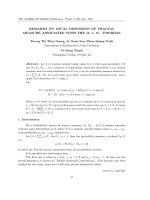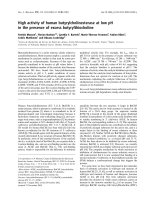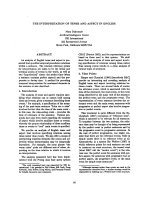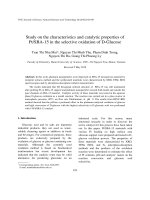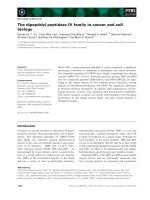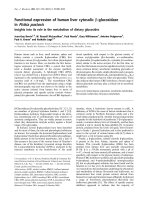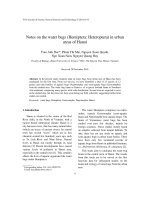Báo cáo "Eliminating on the divergences of the photon self - energy diagram in (2+1) dimensional quantum electrodynamics " pot
Bạn đang xem bản rút gọn của tài liệu. Xem và tải ngay bản đầy đủ của tài liệu tại đây (135.29 KB, 6 trang )
VNU Journal of Science, Mathematics - Physics 23 (2007) 22-27
Eliminating on the divergences
of the photon self - energy diagram
in (2+1) dimensional quantum electrodynamics
Nguyen Suan Han
1
, Nguyen Nhu Xuan
2,∗
1
Department of Physics, College of Science, VNU
334 Nguyen Trai, Hanoi, Vietnam
2
Department of Physics, Le Qui Don Technical University
Received 15 May 2007
Abstract: The divergence of the photon self-energy diagram in spinor quantum electrodynamics
in (2 + 1) dimensional space time- (QED
3
) is studied by the Pauli-Villars regularization and
dimensional regularization. Results obtained by two different methods are coincided if the gauge
invariant of theory is considered carefully step by step in these calculations.
1. Introduction
It is well known that the gauge theories in (2 + 1) dimensional space time though super-
renormalizable theory [1], showing up inconsistence already at one loop, arising from the regular-
ization procedures adopted to evaluate ultraviolet divergent amplitudes such as the photon self-energy
in QED
3
. In the latter, if we use dimensional regularization [2] the photon is induced a topological
mass in contrast with the result obtained through the Pauli-Villars scheme [3], where the photon re-
mains massless when we let the auxiliary mass go to infinity. Other side this problem is important for
constructing quantum field theory with low dimensional modern.
This report is devoted to show up the inconsistencies not arising in QED
3
, if the gauge invariance
of theory is considered carefully step by step in those calculations by above methods of regularization
for the photon self-energy diagram. The paper is organized as follows. In the second section the
photon self-energy is calculated by the dimensional regularization. In the third section this problem is
done by the Pauli-Villars method. Finally, we draw our conclusions.
2. Dimensional regularization
In this section, we calculate the photon self-energy diagram in QED
3
given by (Fig. 1)
∗
Corresponding author. Tel: 84-4-069515341
E-mail: xuan
22
N.S. Han, N.N. Xuan / VNU Journal of Science, Mathematics - Physics 23 (2007) 22-27 23
k k
p
p-k
Figure 1. The photon self-energy diagram.
Following the standard notation, this graph is corresponding to the formula:
Π
µν
(k) =
ie
2
(2π)
3
2
d
3
pT r
γ
µ
ˆp + m
p
2
−m
2
+ i
γ
ν
ˆp − k + m
(p −k)
2
− m
2
+ i
. (1)
In dimensional regularization scheme, we have to make the change :
d
3
p
(2π)
3
2
→ µ
d
n
p
(2π)
n
2
, (2)
where = 3 −n, µ is some arbitrary mass scale which is introduced to preserve dimensional of system.
Make to shift p by p +
1
2
k, the expression (1) has the form :
Π
µν
(k) = ie
2
µ
d
n
p
(2π)
n
2
γ
µ
ˆp +
1
2
ˆ
k
+ m
p +
1
2
k
2
− m
2
+ i
γ
ν
ˆp −
1
2
ˆ
k
+ m
(p −
1
2
k)
2
−m
2
+ i
= ie
2
µ
d
n
p
(2π)
n
2
1
0
dx
P (m)
[m
2
− p
2
+ (x
2
−x )k
2
]
2
,
(3)
with
P (m) =2
m
2
g
µν
+ 2p
µ
p
ν
+ (1 −2x)p
ν
k
µ
+ 2 (x
2
−x )k
µ
k
ν
−g
µν
p
2
+ (1 −2x)pk + (x
2
− x)k
2
− im
µνα
k
α
.
(4)
In the expression (3 ), we have used Feynman integration parameter [5].
Neglecting the integrals that contain the odd terms of p in P (m) which will vanish under the
symmetric integration in p. Then we have
Π
µν
(k) =2ie
2
µ
1
0
dx
d
n
p
(2π)
n
2
×
2p
µ
p
ν
(p
2
−a
2
)
2
−
2x(1 −x)k
µ
k
ν
(p
2
−a
2
)
2
+
2x(1 −x)k
2
g
µν
(p
2
− a
2
)
2
−
g
µν
p
2
−a
2
−
im
µνα
k
α
(p
2
−a
2
)
2
=2ie
2
µ
1
0
dx
d
n
p
(2π)
n
2
2p
µ
p
ν
(p
2
− a
2
)
2
−
g
µν
(p
2
−a
2
)
+
2x(1 − x)(k
2
g
µν
− k
µ
k
ν
)
(p
2
− a
2
)
2
−
im
µνα
k
α
(p
2
− a
2
)
2
.
(5)
24 N.S. Han, N.N. Xuan / VNU Journal of Science, Mathematics - Physics 23 (2007) 22-27
To carry out separating Π
µν
(k) into three terms Π
µν
(k) = Π
1µν
(k)+Π
2µν
(k)+Π
3µν
(k) and using
the following formulae of the dimensional regularization :
I
o
=
d
n
p
(2π)
n
2
1
(p
2
− a
2
)
α
=
i(−π)
n
2
(2π)
n
2
Γ
α −
n
2
Γ(α)
1
(−α
2
)
(
α−
n
2
)
, (6)
I
µν
=
d
n
p
(2π)
n
2
p
µ
p
ν
(p
2
− a
2
)
α
=
g
µν
(−α
2
)
α −1 −
n
2
I
o
, (7)
Γ
2 −
n
2
=
1 −
n
2
Γ
1 −
n
2
, Γ(2) = Γ(1) = 1, (8)
we obtain:
Π
1µν
(k) = 2ie
2
µ
1
0
dx
d
n
p
(2π)
n
2
2p
µ
p
ν
(p
2
−a
2
)
2
−
g
µν
(p
2
−a
2
)
= 0, (9)
Π
2µν
(k) = 2ie
2
µ
1
0
2x(1 −x)
k
2
g
µν
−k
µ
k
ν
dx
d
n
p
(2π)
n
2
1
(p
2
− a
2
)
2
=
e
2
µ
k
µ
k
ν
−k
2
g
µν
(2π)
−1/2
1
0
dx
x(1 −x)
[m
2
− x(1 −x)k
2
]
1/2
, (10)
Π
3µν
(k) = 2e
2
m
µνα
µ
k
α
1
0
dx
d
n
p
(2π)
n
2
×
1
(p
2
− a
2
)
2
= e
2
m
µνα
µ
k
α
i
√
π
√
2
1
0
dx
1
[m
2
−x (1 −x)k
2
]
1/2
. (11)
From the expression (10), we are easy to see that Π
2µν
(0) = 0. So the final result, we find :
Π
µν
(k)
k
2
=0
= [Π
1µν
(k) + Π
2µν
(k) + Π
3µν
(k)] |
k
2
=0
⇒ Π
µν
(k)
k
2
=0
= Π
3µν
(k)
k
2
=0
= 0. (12)
The expression (12) talk to us that in the dimensional regularization method the photon have
additional mass that is differential from zero, even its momentum equal zero.
In the next section, we will study this problem by Pauli-Villars regularization method.
3. Pauli-Villars regularization
Pauli-Villars regularization consists in replacing the singular Green’s functions of the massive
free field with the linear combination [4] :
∆(x) → reg
M
∆(m) = ∆(m) +
i
c
i
∆(M
i
). (13)
Here the symbol ∆
c
(m) stands for the Green’s function of the field of mass m, and the symbol ∆(M
i
)
are auxiliary quantities representing Green’s function of fictitious fields with mass M
i
, while c
i
are
certain coefficients satisfying special conditions. These conditions are chosen so that the regularized
function reg∆(x; m) considered in the configuration representation turns out to be sufficiently regular
in the vicinity of the light cone, or (what is equivalent) such that the function
¯
∆(p; m) in the momentum
representation falls off sufficiently fast in the region of large |p|
2
.
On the base of Pauli-Villars regularization we calculate the polarization tensor operator in QED
3
.
For the vacuum polarization tensor we find the following expression :
Π
M
µν
(k) =
ie
2
(2π)
3/2
n
f
i
c
i
d
3
p
T r
γ
µ
M
i
+ ˆp −
1
2
ˆ
k
γ
ν
M
i
+ ˆp −
1
2
ˆ
k
M
2
i
+
p −
1
2
k
2
×
M
2
i
+
p +
1
2
k
2
, (14)
N.S. Han, N.N. Xuan / VNU Journal of Science, Mathematics - Physics 23 (2007) 22-27 25
with c
o
= 1; M
o
= m; M
i
= mλ
i
;
n
f
i=0
c
i
= 0;
n
f
i=0
c
i
M
i
= 0 (i = 1, 2, n
f
).
For simplicity, but without loss of generality, we may choose both the electron mass and two
mass of auxiliary fields to be positive, the coefficients λ
i
ultimately go to infinity to recover the original
theory.
Π
M
µν
(k) =
ie
2
(2π)
3/2
n
f
i
c
i
d
3
p
1
0
dx
P (M
i
)
[M
2
i
−p
2
+ (x
2
− x)k
2
]
2
. (15)
P (M
i
) =2
M
2
i
g
µν
+ 2 p
µ
p
ν
+ (1 −2x)p
ν
k
µ
+ 2(x
2
− x)k
µ
k
ν
− g
µν
[p
2
+ (1 −2x)pk + (x
2
−x )k
2
] −iM
i
µνα
k
α
.
(16)
Neglecting the integrals that contain the odd terms of p in P (M
i
) we get:
Π
M
µν
(k) =
ie
2
(2π)
3/2
n
f
i
c
i
d
3
p
1
0
dx×
2
M
2
i
g
µν
+ 2p
µ
p
ν
+ 2(x
2
− x)k
µ
k
ν
− g
µν
p
2
−2 g
µν
x
2
− x
k
2
− iM
i
µνα
k
α
[M
2
i
− p
2
+ (x
2
−x )k
2
]
2
.
(17)
The expression Π
M
µν
(k) can be written in the form:
Π
M
µν
(k) =
g
µν
−
k
µ
k
ν
k
2
Π
M
1
(k
2
) + im
µνα
k
α
Π
M
2
(k
2
) + g
µν
Π
M
3
(k
2
). (18)
Set a
2
i
= M
2
i
+ (x
2
−x )k
2
= M
2
i
−x (1 −x)k
2
, we have:
Π
M
1
(k
2
) =4ie
2
n
f
i=0
c
i
1
0
x(1 −x)dx
d
3
p
(2π)
3/2
×
1
(a
2
i
−p
2
)
2
, (19)
Π
M
2
(k
2
) = −
2ie
2
m
n
f
i=0
c
i
M
i
1
0
dx
d
3
p
(2π)
3/2
×
1
(a
2
i
− p
2
)
2
, (20)
Π
M
3
(k
2
) = 2ie
2
n
f
i=0
c
i
1
0
dx
d
3
p
(2π)
3/2
1
(a
2
i
−p
2
)
2
+ 2
1
0
dx
d
3
p
(2π)
3/2
P
2
(a
2
i
− p
2
)
2
. (21)
If we carry out these integrations in the momentum space, it is straightforward to arrive: Π
M
3
(k
2
) = 0
as expected by the gauge invariance.
Here comes the crucial point: we can’t blindly take only one auxiliary field with M = λm
as usual; this choice is missionary conditions
n
f
i=0
c
i
= 0;
n
f
i=0
c
i
M
i
= 0 must be matched. This is
possible only fixing λ = 1 . Thus, the number of regulators must be at leat two, otherwise we can’t
get the coefficients λ
i
becoming arbitrarily large. So, let us take : c
1
= α −1; c
2
= −α; c
j
= 0 when
j > 2.
Where the parameter α can assume any real value except zero and the unity, so that. condition
(15) is satisfied. For λ
1
, λ
2
→ ∞ and apply it to (18). To pay attention Γ(1/2) =
√
π, we have
Π
M
1
=4ie
2
n
f
i=0
c
i
1
0
dxx(1 −x)
d
3
p
(2π)
3/2
×
1
(a
2
i
−p
2
)
2
= −
e
2
k
2
(2π)
−1/2
1
0
dxx(1 −x)
c
o
(a
2
o
)
1/2
+
c
1
(a
2
1
)
1/2
+
c
2
(a
2
2
)
1/2
,
(22)
where
a
2
o
= m
2
− x(1 −x)k
2
; a
2
1
= λ
1
m
2
1
−x (1 −x)k
2
; a
2
2
= λ
2
m
2
2
−x (1 −x)k
2
. (23)
26 N.S. Han, N.N. Xuan / VNU Journal of Science, Mathematics - Physics 23 (2007) 22-27
Thus , when λ
1
, λ
2
→ ∞ :
Π
M
1
(k
2
) → Π
1
(k
2
) = −
e
2
k
2
(2π)
−1/2
1
0
dxx(1 −x)
1
[m
2
− x(1 − x)k
2
]
1/2
, (24)
and consequently, Π
1
(0) = 0.
From (20), we have :
Π
M
2
(k
2
) =
e
2
4mπ
1
0
dx
m
[m
2
− x(1 − x)k
2
]
1/2
+
(α −1)M
1
[M
2
1
− x(1 − x)k
2
]
1/2
−
(α −1)M
2
[M
2
2
−x (1 −x)k
2
]
1/2
.
(25)
Taking the limit λ
1
, λ
2
→ ±∞ (depending on couplings c
1
and c
2
having the same sign or
different sign λ → +∞ or λ → −∞), for photon momentum k=0, yields:
• if λ
1
→ +∞; λ
2
→ ∞: the couplings c
1
, c
2
have the different sign, and α < 0 or α > 0, to
Π
2
(0) = 0. (26)
• if λ
1
→ +∞; λ
2
→ −∞: the couplings c
1
, c
2
have the same sign, and 0 < α < 1
Π
2
(0) =
e
2
√
2m(π)
3/2
(1 + α − 1 + α) =
2e
2
α
√
2m(π)
3/2
. (27)
From the results (26) and (27), we can be written them in the form
Π
2
(0) =
αe
2
√
2mπ
3/2
(1 −s), (28)
with s = sign
1 −
1
α
.
It is obvious that, from (28), we saw: if 0 < α < 1 and s = −1 the couplings c
1
, c
2
have the
same sign Π
2
(0) = 0; in this case photon requires a topological mass, proportional to Π
2
(0), coming
from proper insertions of the antisymmetry sector of the vacuum polarization tensor in the free photon
propagator. If we assume that α is outside this range (0, 1) and c
1
and c
2
have opposite signs and
Π
2
(0) = 0.
We then conclude that this arbitrariness α reflects in different values for the photon mass.
The new parameter s may be identified with the winding number of homologically nontrivial gauge
transformations and also appears in lattice regularization [7].
Now we face another problem: which value of α leads to the correct photon mass? A glance at
equation (21) and we realize that Π
2
(k
2
) is ultraviolet finite by naive power counting. We were taught
that a closed fermion loop must be regularized as a whole so to preserve gauge invariance. However
having done that we have affected a finite antisymmetric piece of the vacuum polarization tensor and,
consequently, the photon mass. The same reasoning applies when, using Pauli-Villars regularization,
we calculate the anomalous magnetic moment of the electron; again, if care is not taken, we may arrive
at a wrong physical result.
In order to get of this trouble we should pick out the value of α that cancels the contribution
coming from the regulator fields. From expression (28), we easily find that this occurs for (c
1
= c
2
)
because in this case the signs of the auxiliary masses are opposite, in account of condition (15). From
(28), we obtain Π
2
(0) =
e
2
√
2mπ
3/2
, in agreement with the other approach already mentioned. We should
N.S. Han, N.N. Xuan / VNU Journal of Science, Mathematics - Physics 23 (2007) 22-27 27
remember that Pauli Villars regularization violated party symmetry (2 + 1) dimensions. Nevertheless,
for this particular choice α, this symmetry is restored as regulator mass get larger and larger.
α < 0, α > 1 0 < α < 1 photon mass
c
1
and c
2
opposite sign Π
2
(0) = 0 equal zero
c
1
and c
2
same sign Π
2
(0) = 0 unequal zero
c
1
= c
2
; α =
1
2
Π
2
(0) = −
e
2
√
2mπ
3/2
4. Conclusion
In depending on sign of the couplings c
1
and c
2
, same and opposite sign the Pauli-Villars
regularization give a result Π
2
(0) =
αe
2
√
2mπ
3/2
(1 − s), where s = sign
1 −
1
α
. Results obtained by
regularization Pauli-Villars and dimensional methods are coincided if the gauge invariance of theory is
considered carefully step by step in these calculations. When c
1
= c
2
; α =
1
2
, the expressions obtained
by the Pauli-Villars and the dimensional method have same results Π
2
(0) =
e
2
√
2mπ
3/2
in QED
3
in
agreement with the other approaches for these problems [6].
Acknowledgments. This work was supported by Vietnam National Research Programme in National
Sciences N406406.
References
[1] S. Dese, R. Jackiw, S. Templeton, Ann. of Phys. 140 (1982) 372.
[2] R. Delbourggo, A.B. Waites, Phys. Lett. B300 (1993) 241.
[3] B.M. Pimentel, A.T. Suzuki, J.L. Tomazelli, Int. J. Mod. Phys. A7 (1992) 5307.
[4] N.N. Bogoliubov, D.V. Shirkov, Introduction to the Theory of Quantumzed Fields, John Wiley-Sons, New York, 1984.
[5] J.M. Jauch, F. Rohrlich, The Theory of Photons and Electrons, Addison-Weslay Publishing Company, London, 1955.
[6] B.M. Pimentel, A.T. Suzuki, J.L. Tomazelli, Int. J. Mod. Phys. A7 (1992) 5307.
[7] A. Coste, M. Luscher, Nucl. Phys. 323 (1989) 631.
